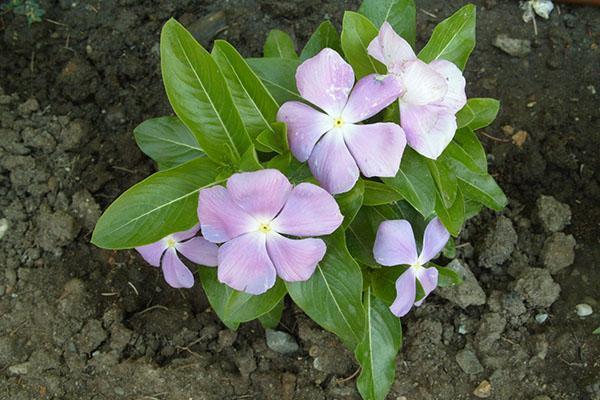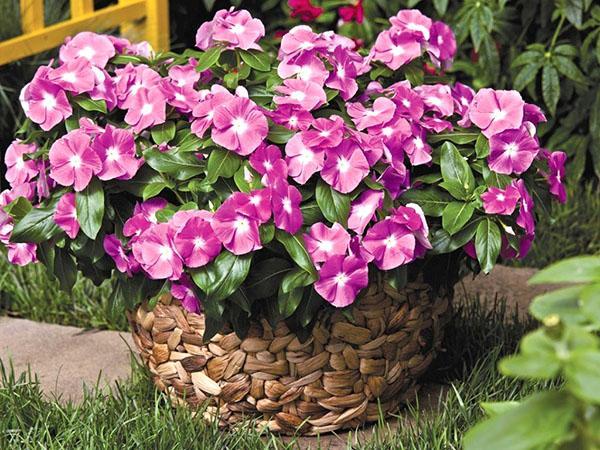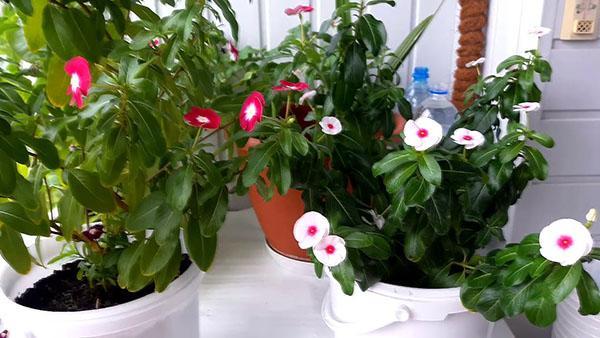How to properly grow a catharanthus at home
 It is quite difficult to grow a beautiful and ever-flowering catharanthus flower at home. If you provide the plant with proper care, then it will delight you with an abundance of bright colors all year round. The stem height reaches 20-60 cm - it all depends on the variety. Large green leaves adorn the buds, collected in a corolla. The flower color can be white, pink or pale lilac. Having figured out in more detail how to care for the plant, you will always be able to enjoy the beauty of the catharanthus.
It is quite difficult to grow a beautiful and ever-flowering catharanthus flower at home. If you provide the plant with proper care, then it will delight you with an abundance of bright colors all year round. The stem height reaches 20-60 cm - it all depends on the variety. Large green leaves adorn the buds, collected in a corolla. The flower color can be white, pink or pale lilac. Having figured out in more detail how to care for the plant, you will always be able to enjoy the beauty of the catharanthus.
Care features

The indoor catharanthus flower grows fast enough, so you should be ready to replant it once a year. The best choice would be a pot a couple of sizes larger than the plant itself. It is important to provide the catharanthus with abundant watering, but at the same time to prevent root rot.
Lighting
 When looking for a place for a plant, the east or west side of the apartment will be the best choice. It is advisable that the pot is not exposed to direct sunlight, but there should be enough light in the room. In the process of caring for a catharanthus at home, do not forget to take it outside (in the warm season), rainfall should not fall on the plant.
When looking for a place for a plant, the east or west side of the apartment will be the best choice. It is advisable that the pot is not exposed to direct sunlight, but there should be enough light in the room. In the process of caring for a catharanthus at home, do not forget to take it outside (in the warm season), rainfall should not fall on the plant.
You should not put the pot on the south side, as the plant can get burned. In winter, fluorescent lamps are used as additional lighting.
Priming
 There are no special preferences when choosing a soil, the earth should be loose and allow air to pass through well. In the process of preparing the mixture, leaf, humus and sod soil are mixed. Peat and the sand is taken in equal proportions and added to the pot. If desired, in the process of caring for the catharanthus at home, they buy ready-made land. Geranium soil is an ideal choice. It is best to lay out the bottom of the pot with expanded clay.
There are no special preferences when choosing a soil, the earth should be loose and allow air to pass through well. In the process of preparing the mixture, leaf, humus and sod soil are mixed. Peat and the sand is taken in equal proportions and added to the pot. If desired, in the process of caring for the catharanthus at home, they buy ready-made land. Geranium soil is an ideal choice. It is best to lay out the bottom of the pot with expanded clay.
A properly prepared mixture and fertilization of the soil 2-3 times a month is the key to rapid flower growth.

Watering and pruning the stem
 It is very important to ensure that the soil in the pot does not have time to dry out, as this is negatively reflected in the growth of the plant. It will be possible to find out that the flower does not have enough watering by the state of the leaves. When the leaves of the catharanthus curl or they begin to turn yellow, then this is a sure sign that the earth has begun to dry out.
It is very important to ensure that the soil in the pot does not have time to dry out, as this is negatively reflected in the growth of the plant. It will be possible to find out that the flower does not have enough watering by the state of the leaves. When the leaves of the catharanthus curl or they begin to turn yellow, then this is a sure sign that the earth has begun to dry out.
 It is recommended to use purified water at room temperature when watering. The liquid from the tap is preliminarily defended for 2-3 days. It is advisable to drain the water that appears in the pan after watering so that the roots do not rot.
It is recommended to use purified water at room temperature when watering. The liquid from the tap is preliminarily defended for 2-3 days. It is advisable to drain the water that appears in the pan after watering so that the roots do not rot.
It is recommended to spray the leaves of the catharanthus daily in the summer. For these purposes, use a liquid at room temperature. During the period from October to March, watering and spraying is reduced.
In the springtime, it is recommended to prune the stem so that the catharanthus becomes more magnificent. At the end of winter, the stem is noticeably stretched out, so that the flowers grow closer together, you should not overlook this procedure.For decorative purposes, you can cut the plant as an exception in summer. The first flowers on the cut stem begin to bloom again after 3 weeks.
Do not forget that the catharanthus is a poisonous plant, which is why it is best to transplant and cut the stem with gloves. Upon completion of the procedure, all tools and hands should be thoroughly washed with soap.
How the catharanthus reproduces at home
 Catharanthus reproduces in several main ways. This process takes place when using seeds, cuttings, or by dividing the bush.
Catharanthus reproduces in several main ways. This process takes place when using seeds, cuttings, or by dividing the bush.
Before growing a catharanthus from seeds at home, you should first familiarize yourself with several rules:
- Seeds are planted at any time of the year. First, the earth must be moistened.
- You will be able to collect the seeds yourself in the spring from a flower or buy purchased ones. In the first case, they are pretreated with a light solution of potassium permanganate, after wrapping them in a gauze bag and dipping them into the liquid for 30 minutes. Then they dry well.
- The seeds are lowered into the soil to a depth of no more than 1.5 cm. The pot is covered with a dark film or placed in a room without light.
- The room temperature should be at least 23 degrees. After 8 days, the first shoots will appear.
Reproduction of catharanthus by cuttings requires preliminary preparation. It is best to perform the procedure in the spring after cutting the stem. The resulting apical stalk is placed in water, where growth stimulants are added. The plant is planted in the soil after the formation of roots. The temperature in the room should not be less than 20 ° C. It will be possible to speed up the growth of the catharanthus by placing a jar on top of the handle or covering it with a film. Do not forget to ventilate the plant.
It is important to divide the bush only in cases with a mature plant. In the process of dividing the catharanthus at home, the root system is divided into several parts, and then planted separately in pots.
Winter period
 Knowing how to preserve the catharanthus in winter will not only save the plant from death, but also accelerate its development in the future. In the cold season, it is important to ensure that the room temperature does not drop below 16-18 degrees. It is not recommended to place the pot on a cold floor, as low temperatures can negatively affect the state of the root system.
Knowing how to preserve the catharanthus in winter will not only save the plant from death, but also accelerate its development in the future. In the cold season, it is important to ensure that the room temperature does not drop below 16-18 degrees. It is not recommended to place the pot on a cold floor, as low temperatures can negatively affect the state of the root system.
 In winter, the air in the room becomes dry due to heating. Maintaining the desired humidity level can be achieved by spraying or using a humidifier. Watering the flower at this time of the year is not often necessary. If at other times of the year the plant is fed with fertilizer 2-3 times a month, then in winter this is not necessary. The soil should be resting at this time of year.
In winter, the air in the room becomes dry due to heating. Maintaining the desired humidity level can be achieved by spraying or using a humidifier. Watering the flower at this time of the year is not often necessary. If at other times of the year the plant is fed with fertilizer 2-3 times a month, then in winter this is not necessary. The soil should be resting at this time of year.
Signs of the disease

Improper care and parasite infestation are the most common causes of flower disease. Find out why the catharanthus does not bloom and its leaves turn yellow by looking at the list below:
- When the root system does not have enough space for growth or fertilization, the leaves begin to actively turn yellow and flowering stops.
- When in a cold room, flowers grow very rarely and chaotically.
- Dry leaves indicate a lack of moisture.
- An excess of light makes the leaves soft and wrinkled.
- When a flower is damaged by brown rust, small white growths appear on the leaves.
If you periodically put a pot of catharanthus in the open air (in summer and spring), then it can start aphid... Sometimes the flower suffers from scale insects and spider mites. Cope with parasites will be obtained using special products and soap solution.